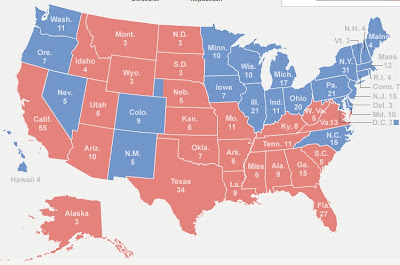 I was curious as to how poorly the electoral college could reflect the popular vote, so I whipped up a program to compute it (assuming only two parties). Below you see the map as it would need to be for the red candidate to win (yeah, yeah, I notice I'm showing the Republican candidate as winning unfairly, but that was just random). The best (or should that be worst?) answer involved all the districts of Nebraska and Maine voting together so I didn't need to split their electoral votes in the picture, although the program did explore those options. While there are some odd states voting together, for expediency I'll ignore that detail since it's not impossible demographic or political shifts could lead to such a result. In order to carry the red states with just over 50% in each, only 21.61% of the popular vote would have to be obtained (21.3% if you count the US territories which currently aren't represented in the electoral college). You can see many of the least populated states are chosen, maximizing the error. I knew the electoral college was bad, but this is astounding! To have a candidate defeated who had more than 78% of the vote would simply be unacceptable.
I was curious as to how poorly the electoral college could reflect the popular vote, so I whipped up a program to compute it (assuming only two parties). Below you see the map as it would need to be for the red candidate to win (yeah, yeah, I notice I'm showing the Republican candidate as winning unfairly, but that was just random). The best (or should that be worst?) answer involved all the districts of Nebraska and Maine voting together so I didn't need to split their electoral votes in the picture, although the program did explore those options. While there are some odd states voting together, for expediency I'll ignore that detail since it's not impossible demographic or political shifts could lead to such a result. In order to carry the red states with just over 50% in each, only 21.61% of the popular vote would have to be obtained (21.3% if you count the US territories which currently aren't represented in the electoral college). You can see many of the least populated states are chosen, maximizing the error. I knew the electoral college was bad, but this is astounding! To have a candidate defeated who had more than 78% of the vote would simply be unacceptable.
To force a tie you need just a slightly smaller percentage of popular vote: 21.52% (or 21.2% if counting the US territories).

Next I took the election results for each of the past three presidential races (the last three all used 2000 census data) and changed my program to look for the minimum subset of the electoral votes actually carried by the winner that still ensured victory. All three required less than 25% of the popular vote for victory (the 2004 minimum solution required 271 electoral votes, not just 270). We can also approach the inherent unfairness of the electoral college another way, by assuming each state's electoral votes per percentage of population is the same. This makes all states more equal, but the very "all or nothing" nature of the system would still allow victory with (270 / 538) * .5 = 25.09% of the popular vote, since you only need just barely over 50% of each state to win all its electoral votes. For this last calculation I ignored the proportional vote system of Maine and Nebraska for simplicity. The rough bottom line is this: a candidate for president can win 75% of the popular vote and still lose the electoral college.
2008: winner is in blue
270 electoral votes
24.0566% of popular vote actually required (includes US territories)

2004: winner is in red
271 electoral votes
24.33% of popular vote actually required (includes US territories)

2000: winner is in red
270 electoral votes
24.575% of popular vote actually required (includes US territories)



No comments:
Post a Comment